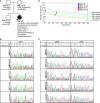Identification and characterization of novel ACD variants: modulation of TPP1 protein level offsets the impact of germline loss-of-function variants on telomere length
- PMID: 33446513
- PMCID: PMC7903889
- DOI: 10.1101/mcs.a005454
Identification and characterization of novel ACD variants: modulation of TPP1 protein level offsets the impact of germline loss-of-function variants on telomere length
Abstract
Telomere biology disorders, largely characterized by telomere lengths below the first centile for age, are caused by variants in genes associated with telomere replication, structure, or function. One of these genes, ACD, which encodes the shelterin protein TPP1, is associated with both autosomal dominantly and autosomal recessively inherited telomere biology disorders. TPP1 recruits telomerase to telomeres and stimulates telomerase processivity. Several studies probing the effect of various synthetic or patient-derived variants have mapped specific residues and regions of TPP1 that are important for interaction with TERT, the catalytic component of telomerase. However, these studies have come to differing conclusions regarding ACD haploinsufficiency. Here, we report a proband with compound heterozygous novel variants in ACD (NM_001082486.1)-c.505_507delGAG, p.(Glu169del); and c.619delG, p.(Asp207Thrfs*22)-and a second proband with a heterozygous chromosomal deletion encompassing ACD: arr[hg19] 16q22.1(67,628,846-67,813,408)x1. Clinical data, including symptoms and telomere length within the pedigrees, suggested that loss of one ACD allele was insufficient to induce telomere shortening or confer clinical features. Further analyses of lymphoblastoid cell lines showed decreased nascent ACD RNA and steady-state mRNA, but normal TPP1 protein levels, in cells containing heterozygous ACD c.619delG, p.(Asp207Thrfs*22), or the ACD-encompassing chromosomal deletion compared to controls. Based on our results, we conclude that cells are able to compensate for loss of one ACD allele by activating a mechanism to maintain TPP1 protein levels, thus maintaining normal telomere length.
Keywords: abnormality of B cell number; bone marrow hypocellularity; fingernail dysplasia; microcephaly; oral leukoplakia; reticulated skin pigmentation; toenail dysplasia.
© 2021 Henslee et al.; Published by Cold Spring Harbor Laboratory Press.
Figures







References
-
- Alter BP, Baerlocher GM, Savage SA, Chanock SJ, Weksler BB, Willner JP, Peters JA, Giri N, Lansdorp PM. 2007. Very short telomere length by flow fluorescence in situ hybridization identifies patients with dyskeratosis congenita. Blood 110: 1439–1447. 10.1182/blood-2007-02-075598 - DOI - PMC - PubMed
-
- Alter BP, Giri N, Savage SA, Peters JA, Loud JT, Leathwood L, Carr AG, Greene MH, Rosenberg PS. 2010. Malignancies and survival patterns in the National Cancer Institute inherited bone marrow failure syndromes cohort study. Br J Haematol 150: 179–188. 10.1111/j.1365-2141.2010.08212.x - DOI - PMC - PubMed
Publication types
MeSH terms
Substances
Grants and funding
LinkOut - more resources
Full Text Sources
Other Literature Sources
Miscellaneous
